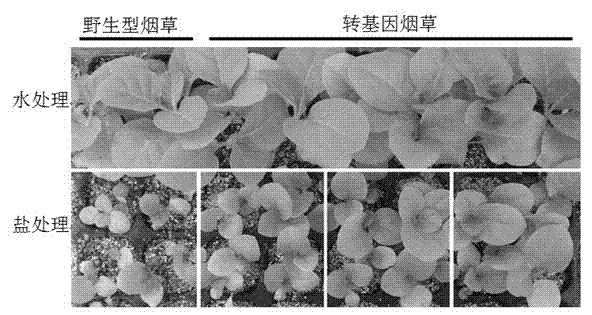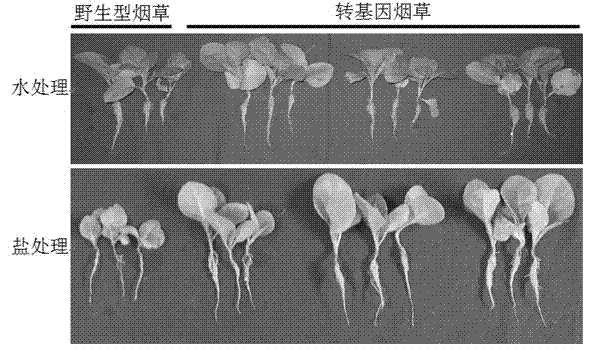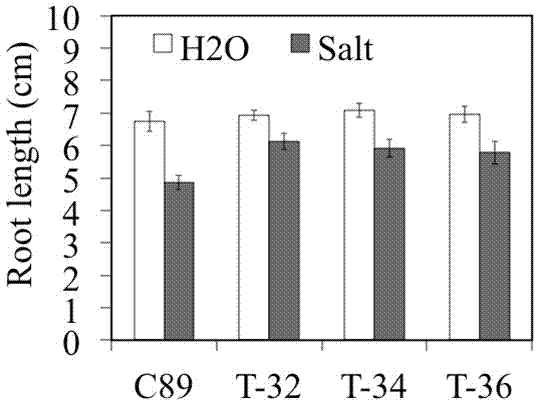Wheat calreticulin fragment TaCRT1-206, and coding sequence and application thereof
A technology of calcium clathrin and wheat calcium network, which is applied to wheat calcium clathrin fragment TaCRT1-206 and its coding sequence and application field, can solve the problem of weakening salt tolerance and achieve the effect of improving salt tolerance
- Summary
- Abstract
- Description
- Claims
- Application Information
AI Technical Summary
Problems solved by technology
Method used
Image
Examples
Embodiment 1
[0026] Example 1 of the present invention: Obtainment of wheat calreticulin fragment TaCRT1-206.
[0027] Take wheat ( Triticum aestivumL) Variety Wangshuibai (preserved in the Applied Genomics Laboratory of Nanjing Agricultural University) was used as a material. During the flowering period, Gibberella spores were sprayed on the ears. The spores used were strong pathogenic Gibberella strains F4, The conidium mixture of F15, F17 and F34 should be covered with moisture immediately after inoculation, and inoculated with water at the same time as a control. After 6 hours, 12 hours, and 24 hours of inoculation, wheat ears were taken respectively, and immediately frozen with liquid nitrogen. Take 700mg of frozen ears of wheat, add 70mg of PVP, grind into powder in liquid nitrogen, add 5mL of 10% trichloroacetic acid / acetone, shake and mix, and precipitate at -20°C for 1 hour; centrifuge at 15,000g at 4°C for 15min, and resuspend the precipitate Place in 5 mL of cold acetone at -...
Embodiment 2
[0028] Example 2 of the present invention: Obtainment of wheat calreticulin fragment TaCRT1-206.
[0029] The coding sequence Ta of wheat calreticulin fragment TaCRT1-206 CRT 1-681 was cloned into the EcoR I and BamH I restriction sites of the expression vector PET-32a, and transformed into E. coli . Pick a single colony and shake overnight in 1 mL of LB (Amp 100μg / mL), transfer to 200 mL of fresh LB medium and shake to bacterial concentration A 600 ≈0.6; add IPTG to a final concentration of 1.0 mM, and incubate at 37°C for 3 hours to induce expression. The bacterial solution was centrifuged at 12,000 g for 5 min, and the pellet was suspended in extraction buffer (3M NaCl, 1 mM PMSF, 50 mM pH8.0 phosphate buffer), sonicated to disrupt the cells, centrifuged at 12,000 g for 20 min, and the supernatant was collected. Equilibrate Ni-Sepharose gel with 10mM imidazole, 50mM pH8.0 phosphate buffer; add cell lysate to combine at room temperature for 20min, wash 3 times with equil...
Embodiment 3
[0030] Example 3 of the present invention: application of the coding sequence of wheat calreticulin fragment TaCRT1-206.
[0031] Using the total cDNA of the panicle of Wangshuibai as a template, PCR amplification was carried out with primer P2. The P2 primer pair is as follows: F-5'-CAGC TCTAGA ATGTTTCTTCCAGGAGAAGTTC-3'; R-5'-GAAG GGATCC CCAGTGCTCGTAGATGCT-3'. Amplified PCR products were amplified with restriction endonucleases Xba I and Bam After HI was digested, it was connected with the binary expression vector pBI121 that was digested with the same restriction endonuclease to obtain the Ta CRT gene fragment Ta CRT 1-681 overexpression vector. The obtained expression vector was transformed into Agrobacterium strain LBA4404 by freeze-thaw method, and screened by LB medium containing 50 μg / ml kanamycin and 50 μg / ml rifampicin to obtain positive clones. With reference to the article method published on pages 1229-1231 of the 227th issue of Science by Horsch et al. ...
PUM
 Login to View More
Login to View More Abstract
Description
Claims
Application Information
 Login to View More
Login to View More - R&D
- Intellectual Property
- Life Sciences
- Materials
- Tech Scout
- Unparalleled Data Quality
- Higher Quality Content
- 60% Fewer Hallucinations
Browse by: Latest US Patents, China's latest patents, Technical Efficacy Thesaurus, Application Domain, Technology Topic, Popular Technical Reports.
© 2025 PatSnap. All rights reserved.Legal|Privacy policy|Modern Slavery Act Transparency Statement|Sitemap|About US| Contact US: help@patsnap.com



